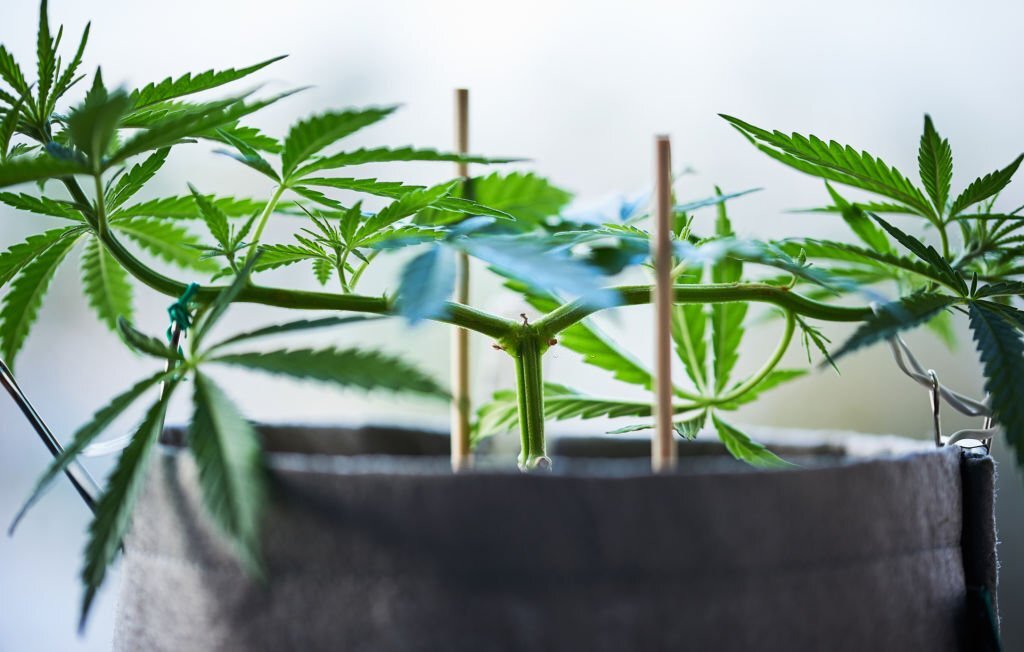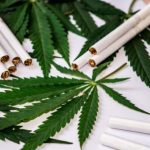🔥 Website for Sale - Contact Us
Are you tired of uneven, inconsistent buds in your cannabis harvest? It’s time to revolutionize your growing experience with the cannabis mainlining technique! In this step-by-step guide, we will unveil the secrets of mainlining, a game-changing method that promises bigger and equal size buds every time.
This guide covers everything you need to know about how to implement mainlining technique into your grow tent setup, and tips and tricks to help you mainline like a pro. So, let’s get mainlining!
II. What is Cannabis Mainlining?
A. Definition and Overview of the Technique
The cannabis mainlining technique, also known as “manifolding,” is a plant training method that focuses on creating a symmetrical and balanced structure in your cannabis plants. This technique involves careful pruning and manipulation of the plant to form a central “hub” from which all primary branches grow, ensuring that each branch receives an equal share of the plant’s resources.
Here’s an overview of the mainlining technique:
Purpose: The primary goal of mainlining is to achieve equal size buds throughout the plant by evenly distributing nutrients and energy to each branch. This results in a bigger and more consistent harvest.
Pruning: Mainlining involves strategic pruning of the plant’s growth tips and lower branches to create a more efficient structure. This process encourages the development of a manifold or “hub” that serves as the foundation for all primary branches, promoting equal growth and bud size.
Low-Stress Training (LST): The mainlining technique incorporates elements of LST, which involves gently bending and securing branches to guide their growth and create a more uniform canopy. This process ensures that all branches receive adequate light and airflow, further promoting equal bud development.
Recovery and growth: After the initial pruning and training, the mainlining process requires a period of recovery and growth for the plant to establish its new structure. This stage is crucial for the plant to develop a strong manifold and set the stage for optimal bud development.
By implementing the mainlining technique, cannabis growers can create a more uniform plant structure that supports equal size buds, maximizes light penetration, and improves overall plant health.
B. The Advantages of Mainlining in Cannabis Cultivation
The mainlining technique has gained popularity among cannabis growers due to the numerous advantages it offers in terms of plant structure, yield, and harvest quality. Here are the key benefits of mainlining method:
Equal size buds: Mainlining ensures that each branch receives an equal share of nutrients and energy, promoting consistent and uniform bud development. This results in equal size buds throughout the plant, enhancing the overall aesthetic and quality of your harvest.
Increased yields: By creating a balanced and efficient plant structure, mainlining can help increase overall yields. The technique allows for better light penetration and airflow. Additionally, mainlining minimizes the growth of smaller, underdeveloped buds, further contributing to an increased yield.
Improved plant health: Mainlining promotes better airflow and light distribution within the plant canopy, reducing the risk of mold, mildew, and pest infestations.
Easier plant management: A well-structured and symmetrical plant is easier to manage and maintain throughout the growing process. Mainlining simplifies pruning, training, and monitoring, ultimately making your cannabis cultivation experience more enjoyable and efficient.
Consistent results: Mainlining allows growers to achieve more consistent results across multiple harvests. By following the mainlining technique, you can expect to produce plants with equal size buds and increased yields, time and time again.
In summary, the mainlining technique offers a range of benefits that can help enhance your cannabis cultivation experience. By focusing on creating a more efficient and balanced plant structure, mainlining paves the way for equal size buds, higher yields, and a more satisfying growing experience.
III. Step-by-Step Guide to Mainlining Cannabis Plants
A. Choosing the Right Strain for Mainlining
While the mainlining technique can be applied to various cannabis strains, selecting the right strain is crucial for success. Here are factors to consider when choosing the ideal strain for mainlining:
Growth pattern: Strains with a naturally bushy growth pattern and strong lateral branching are well-suited for mainlining. These strains can easily adapt to pruning and training, resulting in a more efficient and balanced plant structure.
Resilience: Mainlining involves pruning and manipulation of the plant, so it’s essential to choose a strain that is resilient and can recover quickly from stress. Strains with strong genetics and robust growth characteristics are more likely to thrive under the mainlining technique.
Flowering time: Mainlining requires additional time for pruning, training, and recovery. Strains with short flowering time, are more suitable for mainlining as they allow quicker turnaround between harvests.
Yield potential: Since one of the main objectives of mainlining is to increase yields, selecting a strain with high yield potential can further enhance the benefits of this technique. Strains known for their outstanding yield respond well to mainlining.
In conclusion, choosing the right strain for mainlining is a crucial step in ensuring the success of this technique. Selecting a strain with the appropriate growth pattern, resilience, and flowering time can maximize the benefits of mainlining.
B. Preparing Your Cannabis Plants for Mainlining
Here are the essential steps to prepare your plants for mainlining.
Healthy seedlings or clones: Start with robust and healthy seedlings or clones to ensure that your plants can withstand the pruning and training involved in mainlining. Strong and well-established plants are more likely to recover quickly and adapt to the new growth pattern.
Adequate vegetative growth: Allow your plants to grow and establish themselves in the vegetative stage before starting the mainlining process. Wait until your plants develop at least three to four nodes before initiating the technique. This ensures that your plants have sufficient growth to work with and can recover effectively from pruning.
Proper nutrients: Providing your plants with the right nutrients is crucial during the mainlining process, as it helps promote growth and recovery. Ensure that your plants receive a balanced blend of macronutrients (nitrogen, phosphorus, potassium, calcium, magnesium, and iron).
Clean and sanitized tools: Pruning and training your plants for mainlining requires sharp and sanitized tools to minimize the risk of infection and disease. Ensure all your pruning tools are clean and disinfected before starting the mainlining process.
By following these steps, you can prepare your cannabis plants for the mainlining technique and create a strong foundation to get consistent-size buds. Proper preparation and attention to detail will ensure that your plants can adapt to the mainlining technique and fully reap its benefits.
C. Step 1: Topping the Cannabis Plant
The first step in the mainlining process involves topping your cannabis plant to promote the development of two primary branches. This step is crucial for establishing the foundational structure for mainlining. Here are guidelines to correctly top your cannabis plant.
Identify the right time: Ensure that the plant has at least three to four nodes before topping. This signals that the plant is old enough to withstand the added stress of topping.
Locate the growth tip: The growth tip is the central point at the top of the plant, from which new growth emerges. It is usually found between the two newest sets of leaves. Carefully inspect your plant and identify the growth tip.
Sterilize your tools: Use a sharp and sanitized pair of pruning shears or scissors for topping.
Cut the growth tip: Position your pruning shears or scissors about 1/4 inch above the growth tip, ensuring that you leave a small portion of the stem intact. Make a clean, straight cut to remove the growth tip. This will encourage the plant to redirect its energy and resources to the two branches immediately below the cut.
Monitor the plant’s recovery: After topping, it’s essential to monitor your plant’s recovery and ensure it’s adapting well to the new growth pattern. Pay attention to the development of the two primary branches, and maintain optimal growing conditions to promote a healthy recovery.
Topping is a critical step in the mainlining process, as it sets the stage for a balanced and symmetrical plant structure. By carefully following these guidelines, you can effectively top your cannabis plant for equal size buds and higher yields.
D. Step 2: Creating the Mainline Structure
Once your cannabis plant has recovered from topping, it’s time to create the mainline structure. This step involves training the two primary branches and removing unwanted growth to establish a balanced and efficient plant structure. Follow these guidelines to create the mainline structure:
Select the primary branches: After topping, your plant should have two main branches emerging from the cut. These branches will form the foundation of your mainline structure. Ensure that they are healthy and well-developed before proceeding.
Remove lower growth: Prune away any lower branches, leaves, and growth tips beneath the two main branches. This step is crucial for focusing the plant’s energy and resources on the mainline structure and promoting equal growth among future colas.
Apply Low-Stress Training (LST): Gently bend the two primary branches outward and away from the center of the plant. This will create a “Y” or “V” shape and encourage an even distribution of light and airflow within the plant canopy. Secure the branches in their new position using soft ties or plant twist ties, while not damaging the plant’s stem or branches.
Repeat the process for additional colas: As your plant grows and develops more nodes, you may want to create additional colas by repeating the topping and training process. This will result in a more complex mainline structure with multiple colas.
By following these steps, you can create a well-balanced mainline structure that promotes equal growth among all future colas.
E. Step 3: Training and Pruning Branches
With the mainline structure in place, the next step is to train and prune the branches. This process will help maintain the structural balance and ensure that all future colas receive equal structure share. Here are guidelines for training and pruning:
Identify secondary branches: As your plant grows, new secondary branches will emerge from the primary branches. These secondary branches will eventually develop into colas. Identify and select the strongest and healthiest secondary branches for further training.
Remove unwanted growth: Prune away any weak or underdeveloped secondary branches, as well as growth beneath the primary branches. This helps to direct the plant’s resources toward the selected secondary branches, promoting equal growth among the future colas.
Train secondary branches: Gently bend and secure the secondary branches to create an even canopy. Use soft ties or plant twist ties to maintain the branches in their new position, ensuring they are evenly spaced and receive adequate light and airflow. This step is crucial for achieving equal size buds and optimizing light penetration within the plant canopy.
Prune during flowering: Once your plant enters the flowering stage, prune any excess growth in the lower portion of the plant. This helps to focus the plant’s energy on bud development and further promotes equal growth among the colas.
By diligently training and pruning your cannabis plant, you can maintain the balanced mainline structure and ensure that all future colas receive an equal share of resources.
C. Step 1: Topping the Cannabis Plant
The first step in the mainlining process involves topping your cannabis plant to promote the development of two primary branches. This step is crucial for establishing the foundational structure for mainlining. Here are guidelines to top your cannabis plant:
Identify the right time: Ensure the plant has at least three to four nodes before topping. This provides enough plant material to work with and helps your plant to recover effectively from the topping process.
Locate the growth tip: The growth tip is the central point at the top of the plant, from which new growth emerges. It is found between the two newest sets of leaves.
Sterilize your tools: Use a sharp and sanitized pair of pruning shears or scissors for topping.
Cut the growth tip: Position your pruning shears or scissors about 1/4 inch above the growth tip, leaving a small portion of the stem intact. Make a clean, straight cut to remove the growth tip. This encourages the plant to redirect its energy and resources to the two branches immediately below the cut.
Monitor the plant’s recovery: After topping, it’s essential to monitor your plant’s recovery and ensure that it’s adapting well to the new growth pattern. Pay attention to the development of the two primary branches, and maintain optimal growing conditions to promote a healthy recovery.
D. Step 2: Creating the Mainline Structure
After topping your cannabis plant and allowing it to recover, the next step is to create the mainline structure. This process involves training the two primary branches and removing any unwanted growth. Follow these guidelines to create the mainline structure:
Select the primary branches: Your plant should now have two primary branches emerging from the cut made during topping. These branches will form the foundation of your mainline structure. Make sure they are healthy and well-developed before proceeding.
Remove lower growth: Prune away any lower branches, leaves, and growth tips beneath the two primary branches. This step is crucial for focusing the plant’s energy and resources on the mainline structure and promoting equal growth among future colas.
Apply Low-Stress Training (LST): Gently bend the two primary branches outward and away from the center of the plant. This will create a “Y” or “V” shape and encourage an even distribution of light and airflow within the plant canopy. Secure the branches in their new position using soft ties or plant twist ties, being careful not to damage the plant’s stem or branches.
Repeat the process for additional colas: As your plant grows and develops more nodes, you may choose to create additional colas by repeating the topping and training process.
By following these steps, you can create a well-balanced mainline structure that promotes equal growth among all future colas.
E. Step 3: Training and Pruning Branches
The next step is to train and prune the branches. This process helps maintain the balanced structure and ensures all future colas receive equal resources. Follow these guidelines for training and pruning:
Identify secondary branches: As your plant grows, new secondary branches will emerge from the primary branches. These secondary branches will eventually develop into colas. Identify and select the strongest and healthiest secondary branches for further training.
Remove unwanted growth: Prune away any weak or underdeveloped secondary branches and growth beneath the primary branches. This help to direct the plant’s growth energy toward the selected secondary branches, promoting equal growth among the future colas.
Train secondary branches: Gently bend and secure the secondary branches to create an even canopy. Use soft ties or plant twist ties to maintain the branches in their new position, ensuring they are evenly spaced and receive adequate light and airflow.
IV. Tips and Tricks for Successful Cannabis Mainlining
Here are useful tips and tricks that can help implement the mainlining technique:
Start with a healthy plant: For the best results, begin the mainlining process with a healthy, well-established plant. A strong and vigorous plant is more resilient and better able to recover from topping and training.
Choose the right strain: Some cannabis strains are better suited for mainlining than others. Indica-dominant strains, with their short and bushy growth habit, may be more manageable and responsive to mainlining compared to Sativa-dominant strains, which tend to be taller and more stretchy.
Be patient: Mainlining is a time-consuming process that requires a longer vegetative growth period. Don’t rush your plant through the various stages of training and pruning, and be prepared to invest time.
Provide optimal growing conditions: Ensure the plant receives adequate light, water, and nutrients throughout the mainlining process. Maintaining the proper environmental conditions is critical. Here is the best grow tent setup for different types of strains.
By following these tips and tricks, you can successfully implement the cannabis mainlining technique and achieve equal size buds every time.
V. Common Mistakes and How to Avoid Them
Cannabis mainlining can be a highly effective technique for achieving equal size buds and maximizing yields, but it’s not without its challenges.
Here are some common mistakes to avoid.
Topping too early or too late: Topping your plant at the wrong time can hinder its growth and development. Wait until your plant has at least 4-6 nodes before topping, to ensure the plant is strong enought for mainlining. Topping too late may result in a plant that is too tall or lanky to manage effectively.
Over-pruning: While pruning is necessary to maintain the mainline structure, over-pruning can stress your plant and limit its growth potential. Be selective when pruning and focus on removing only weak or underdeveloped branches and growth below the primary branches.
Rushing the process: Mainlining requires patience and a longer vegetative growth period. Avoid rushing your plant through the various stages of training and pruning, and allow it ample time to develop its mainline structure.
Inconsistent maintenance: Failing to maintain the mainline structure throughout the growth cycle can undermine the benefits of the technique. Stay consistent in your training, pruning, and maintenance efforts to ensure your plant receives the benefits of mainlining.
VI. Conclusion
The cannabis mainlining technique offers numerous benefits for cultivators seeking equal size buds, higher yields, and more efficient use of resources. By following the critical steps involved in the mainlining process, including topping, creating the mainline structure, training, and pruning branches, and maintaining the structure throughout the growth cycle, growers can optimize their plant’s potential.
In conclusion, the cannabis mainlining technique can be a rewarding and effective method for achieving equal size buds and maximizing yields.





